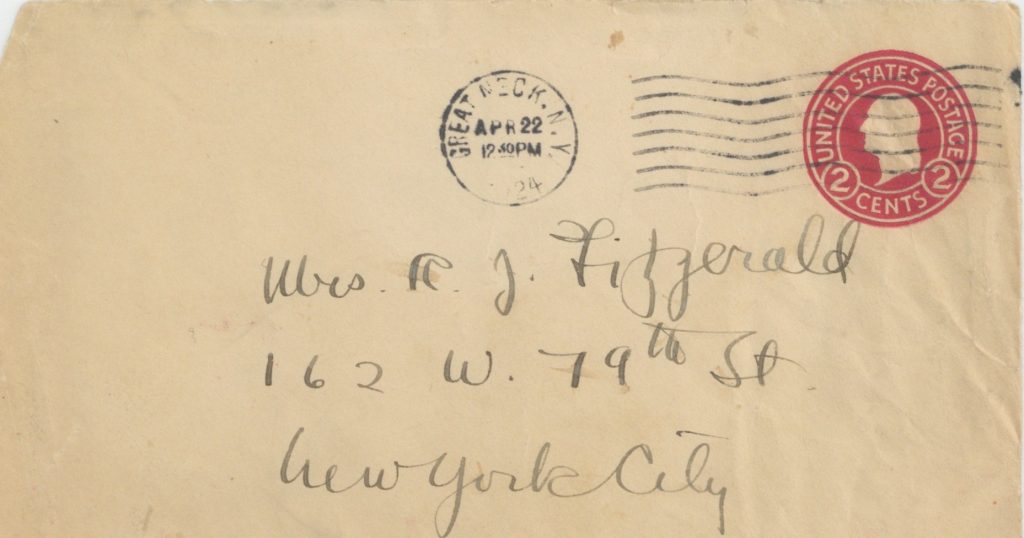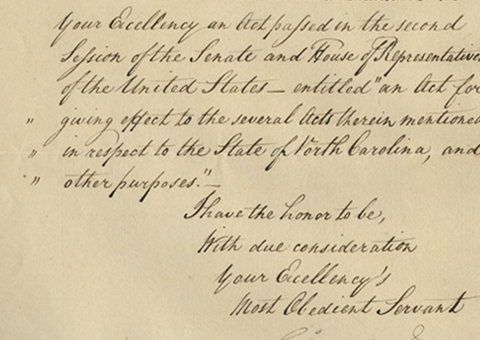In a Newly Discovered and Apparently Unpublished Letter to a Family Member, F. Scott Fitzgerald Writes of Family, Faith, Women, and Mentions His Great 1924 Trip to Europe



"I used to like Tom too, but since I ceased being a Catholic he thinks I’m a lost soul"
He categorically denies that he ever said, as claimed in a magazine article, that “All women over 35 should be murdered.”
Fitzgerald writes a woman who has discovered they are related, confirming her supposition
Obtained from the direct descendant of the recipient
When he was a fifteen-year-old high school student,...
He categorically denies that he ever said, as claimed in a magazine article, that “All women over 35 should be murdered.”
Fitzgerald writes a woman who has discovered they are related, confirming her supposition
Obtained from the direct descendant of the recipient
When he was a fifteen-year-old high school student, F. Scott Fitzgerald spent spring break with his cousin Cecilia (“Ceci”) Taylor, in Norfolk, Virginia. He was near the end of his first year at the Newman School, a Catholic boarding school in Hackensack, New Jersey, where he had been sent in September 1911 because of his poor academic performance back home in St. Paul, Minnesota. Ceci, sixteen years his senior and a widow with four children, was Scott’s favorite among his relatives, and he would immortalize her as the widow Clara (“She made her goodness such an asset”) in This Side of Paradise. During a break Fitzgerald accompanied his cousin Ceci on a trip to Woodstock College, near Baltimore, to visit her brother Tom Delihant, a Jesuit scholastic finishing up the nearly two decades of study and contemplation required before his ordination as a priest. Delihant made quite an impression on the teenager; they kept in touch for years and Fitzgerald’s admiration was unabated even as the young author renounced his on-again, off-again faith in his journal in 1917, the same year he met future wife Zelda Sayre: “A year of enormous importance. Work, and Zelda. Last year as a Catholic.”
Upon his discharge from the army on February 14, 1919, he moved to New York City, where he unsuccessfully begged the editors of various newspapers for a job. He then turned to writing advertising copy to sustain himself while seeking a breakthrough as an author of fiction. Fitzgerald wrote to Zelda frequently, and by March 1920 he had sent Zelda his mother’s ring, and the two became officially engaged. They married in April 1920. The Fitzgeralds subsisted in relative poverty at that time. Still aspiring to a lucrative career in literature, he wrote several short stories and satires in his spare time. Rejected over 120 times, he sold only one story, “Babes in the Woods”, and received $30. He decided to make one last attempt to become a novelist and to staked everything on the success or failure of a book. He worked day and night and published “This Side of Paradise” – an autobiographical account of his Princeton years and his romances with Ginevra, Zelda, and others. Fitzgerald’s debut novel appeared in bookstores on March 26, 1920 and became an instant success. “This Side of Paradise” sold approximately 40,000 copies in the first year. He published two more novels in 1922, the year he moved to Great Neck, Long Island.
In 1924, Fitzgerald began work on his greatest novel, “The Great Gatsby”, and it would be published in 1925, smack in the middle of the Roaring Twenties scene that he depicted in his book. Also, in the spring of 1924 Fitzgerald and Zelda Neck decided that they would go to France and “live on practically nothing a year.” They were escaping, Fitzgerald wrote, “from extravagance and clamor and from all the wild extremes among which we had dwelt for five hectic years, from the tradesmen who laid for us and the nurse who bullied us and the couple who kept our house for us and knew us all too well. We were going to the Old World to find a new rhythm for our lives, with a true conviction that we had left our old selves behind forever and with a capital of just over seven thousand dollars.”
In 1923, an article had appeared in Metropolitan Magazine by a B.F. Wilson, who claimed that in an interview, Zelda told Wilson that Scott had said “All Women Over 35 Should Be Murdered.” He used the phrase in the title. In this letter, Scott absolutely denies ever saying that.
Autograph letter signed, Great Neck, April 22, 1924, to Mrs. Reginald Joseph Fitzgerald (Elinor Hayden Slattery Fitzgerald), confirming that he was no longer a Catholic, that family members were no longer speaking with him as a result, and that he and the recipient were cousins. “I was delighted to hear from you and know I had another cousin. That is you’re Ceci’s first cousin and that makes us some sort of relation. Isn’t she a wonder? One of the most charming and remarkable people I’ve ever known. I used to like Tom too, but since I ceased being a Catholic he thinks I’m a lost soul and won’t come near me. I deny all complicity in that “all women over 35” article was written by a lady interviewer and titled by a silly editor. Evidently you don’t know that grandmother died last February. She was over 90 and I hated to seeker pass away.
“I’m afraid that our meeting will have to be postponed a little while as we are sailing to Europe the end of this week. However I’m saving your letter and I’ll drop you a line as soon as we return. We must certainly meet.” The postmarked envelope in his hand is still present.
We obtained this unique letter about his faith and family from the Fitzgerald descendants, and it has never before been offered for sale.

Frame, Display, Preserve
Each frame is custom constructed, using only proper museum archival materials. This includes:The finest frames, tailored to match the document you have chosen. These can period style, antiqued, gilded, wood, etc. Fabric mats, including silk and satin, as well as museum mat board with hand painted bevels. Attachment of the document to the matting to ensure its protection. This "hinging" is done according to archival standards. Protective "glass," or Tru Vue Optium Acrylic glazing, which is shatter resistant, 99% UV protective, and anti-reflective. You benefit from our decades of experience in designing and creating beautiful, compelling, and protective framed historical documents.
Learn more about our Framing Services











































































































